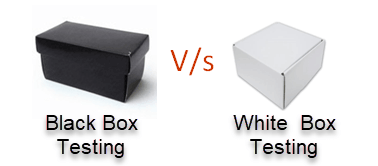Difference Between Black Box and White Box Testing
Black Box Testing vs White Box Testing: Key Difference
- In Black Box, testing is done without the knowledge of the internal structure of program or application whereas in White Box, testing is done with knowledge of the internal structure of program.
- When we compare Blackbox and Whitebox testing, Black Box test doesn’t require programming knowledge whereas the White Box test requires programming knowledge.
- Black Box testing has the main goal to test the behavior of the software whereas White Box testing has the main goal to test the internal operation of the system.
- Comparing White box testing and Black box testing, Black Box testing is focused on external or end-user perspective whereas White Box testing is focused on code structure, conditions, paths and branches.
- Black Box test provides low granularity reports whereas the White Box test provides high granularity reports.
- Comparing Black box testing vs White box testing, Black Box testing is a not time-consuming process whereas White Box testing is a time-consuming process.
What is Black Box testing?
In Black-box testing, a tester doesn’t have any information about the internal working of the software system. Black box testing is a high level of testing that focuses on the behavior of the software. It involves testing from an external or end-user perspective. Black box testing can be applied to virtually every level of software testing: unit, integration, system, and acceptance.
What is White Box testing?
White-box testing is a testing technique which checks the internal functioning of the system. In this method, testing is based on coverage of code statements, branches, paths or conditions. White-Box testing is considered as low-level testing. It is also called glass box, transparent box, clear box or code base testing. The white-box Testing method assumes that the path of the logic in a unit or program is known.
Black Box Testing Vs. White Box Testing
Below is the main difference between White Box and Black Box Testing:

| Parameter | Black Box testing | White Box testing |
|---|---|---|
| Definition | It is a testing approach which is used to test the software without the knowledge of the internal structure of program or application. | It is a testing approach in which internal structure is known to the tester. |
| Alias | It also knowns as data-driven, box testing, data-, and functional testing. | It is also called structural testing, clear box testing, code-based testing, or glass box testing. |
| Base of Testing | Testing is based on external expectations; internal behavior of the application is unknown. | Internal working is known, and the tester can test accordingly. |
| Usage | This type of testing is ideal for higher levels of testing like System Testing, Acceptance testing. | Testing is best suited for a lower level of testing like Unit Testing, Integration testing. |
| Programming knowledge | Programming knowledge is not needed to perform Black Box testing. | Programming knowledge is required to perform White Box testing. |
| Implementation knowledge | Implementation knowledge is not requiring doing Black Box testing. | Complete understanding needs to implement WhiteBox testing. |
| Automation | Test and programmer are dependent on each other, so it is tough to automate. | White Box testing is easy to automate. |
| Objective | The main objective of this testing is to check what functionality of the system under test. | The main objective of White Box testing is done to check the quality of the code. |
| Basis for test cases | Testing can start after preparing requirement specification document. | Testing can start after preparing for Detail design document. |
| Tested by | Performed by the end user, developer, and tester. | Usually done by tester and developers. |
| Granularity | Granularity is low. | Granularity is high. |
| Testing method | It is based on trial and error method. | Data domain and internal boundaries can be tested. |
| Time | It is less exhaustive and time-consuming. | Exhaustive and time-consuming method. |
| Algorithm test | Not the best method for algorithm testing. | Best suited for algorithm testing. |
| Code Access | Code access is not required for Black Box Testing. | White box testing requires code access. Thereby, the code could be stolen if testing is outsourced. |
| Benefit | Well suited and efficient for large code segments. | It allows removing the extra lines of code, which can bring in hidden defects. |
| Skill level | Low skilled testers can test the application with no knowledge of the implementation of programming language or operating system. | Need an expert tester with vast experience to perform white box testing. |
| Techniques |
Equivalence partitioning is Black box testing technique is used for Blackbox testing. Equivalence partitioning divides input values into valid and invalid partitions and selecting corresponding values from each partition of the test data. Boundary value analysis checks boundaries for input values. |
Statement Coverage, Branch coverage, and Path coverage are White Box testing technique. Statement Coverage validates whether every line of the code is executed at least once. Branch coverage validates whether each branch is executed at least once Path coverage method tests all the paths of the program. |
| Drawbacks | Update to automation test script is essential if you to modify application frequently. | Automated test cases can become useless if the code base is rapidly changing. |
